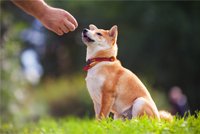The first year of life is an important time for any dog. It is when they develop a lot of their habits, learn to socialize, and establish their role in the family. Early obedience training makes the pet more enjoyable, keeps them feeling secure, and enables them to understand you expect of them. Here is how to start.
Welcome Them Home
Dogs learn best when they have structure and consistency in what you expect of them. Begin their training as soon as they arrive home. Make certain that you do not reward begging with snacks and that the dog remains in its own bed at night.
Make certain meals and bathroom breaks take place at consistent times and watch their behavior between meals for faster housebreaking. Take the puppy immediately outside whenever it wakes up or begins to sniff around. Use the puppy’s name frequently to help it identify it as its own.
Introduce the Basics
Once the puppy is comfortable in the home you finish housetraining, it is time for it to learn a few more commands. Sit, stay, and down are important terms for every dog to understand as well as the terms come and no. The length of time it takes for a dog to learn all of these words will vary by breed and by the animal.
Establish Training Areas
Puppies are excitable and have a hard time focusing on anything when there are many distractions. Take the animal into a quiet room each day and spend about 15 minutes working on basic commands. Continue to use these commands during daily life so the pup will begin to understand what you expect of them.
Increase Social Skills
Socializing is important from the start, but it is a good idea to keep young pets away from dog parks and a lot of other animals until they receive all of their vaccination, which should be at about four months. Begin leash training as soon as the dog has become familiar with its name. Establish a familiar route in a quiet area and keep the walks an acceptable length for the age of the animal.
Experts recommend about five minutes of exercise once or twice a day per month of age. For example, a six-month-old puppy can take a 30-minute walk twice a day. Once the pet comfortably completes their walk and shows good leash manners by not pulling on the leash or jumping, it is time to try new routes. This allows them to explore and offer new training scenarios.
Begin Advanced Training
There is no perfect age when advanced training can take place. The time to learn the techniques to become a hunting companion or therapy dog or just to learn advanced commands and tricks is whenever they master basic skills. This time could be during the puppy months or when the dog is more mature.
Maintain the Training
Dogs do not remain obedient if their owners allow behavioral lapses. If the owner occasionally allows the dog to bark at the neighbors or jump on visitors, it will become difficult to prevent these actions later on. A refresher obedience course is beneficial for the pet and the owner when training has lapsed. Pets can easily learn new skills or relearn them at any age.
Some pet owners have the ability to teach their new puppies at home. Others feel more comfortable with a little help. At Elite Dogs Training And Boarding we are happy to provide a place where owners and their pets can bond and build their skills. Our classes are perfect for dogs of any age and size. Contact us to learn more.

